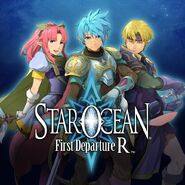Star Ocean: First Departure (スターオーシャン1 ファーストディパーチャー, Sutā Ōshan Wan Fāsuto Dipāchā?) is the remake of the series' original game Star Ocean, originally released for the PlayStation Portable system. It is the fifth Star Ocean game to have been released.
An enhanced port, Star Ocean: First Departure R, was released for PlayStation 4 and Nintendo Switch on December 5, 2019,[1] featuring updated visuals and voices.
Differences[]
- New voice actors, animated cutscenes and character portraits, as well as a new character designer. All major story events now have voice acting.
- New recruitable characters: Erys Jerand and Welch Vineyard.
- The plot remains mostly unchanged from Star Ocean. However, new characters, and consequentially, new Private Actions and endings were added. They increased from the SNES version to around 80 different endings.
- Unlike the original game where the player has to select which enemy to attack and see the character go towards that enemy and attack, the player now has full manual control of any party member.
- Linking special attacks to make combos and increase the amount of damage is now possible.
- The MP cost of most Special Arts were changed along with the level requirement to be learned; however, the art slots is reduced to only two.
- Skills, Talents and Item Creation specialties are virtually the same from those from Second Evolution, itself mostly taken the The Second Story. Most items (except weapons, valuables and accessories) are also carried over.
- Scholar skills were removed.
- The Mastery (also called Proficiency) system was introduced.
Music[]
Collected into the album Star Ocean: First Departure Original Soundtrack, the remake features the remastered tracks arranged by Motoi Sakuraba that appeared in the Star Ocean Soundtrack.
It has also a theme song, "Heart", performed by the Japanese group Asunaro, and three added tracks: "Come on Bunny" and "Mission to the Deep Space" from The Second Story's soundtrack, and "Mother Ocean" from the Star Ocean Perfect Sound Collection.
Development[]
The first details about the game were revealed at the "Star Ocean Special Stage" during the Square Enix Party 2007, alongside those of Star Ocean: Second Evolution, which was released four months later. Yoshinori Yamagishi, producer of the series, stated that he wanted the remakes to feel as though they are completely new games.[2]
First Departure was produced using an improved version of Star Ocean: The Second Story's engine, which introduced prerendered backgrounds and 3D battle fields. The same engine was used for The Second Story's remake Star Ocean: Second Evolution, produced at the same time as this game. Production I.G provided the artwork and animated cutscenes for the game.[3] The voice actors were fully re-cast and it has massive amounts of voiced dialogue in comparison to the original. Plot-wise, it remains virtually unchanged, with some new additions regarding optional scenarios and the two new characters.

Eternal Edition PSP.
The English localization was handled by Nanica, Inc., with voiceover production services provided by Epcar Entertainment, Inc.[4] Recordings were made at the Oracle Post studios in Burbank, CA. Alongside the regular version of First Departure, a limited edition package, the Eternal Edition, was released. It included a branded PSP Slim & Lite and an alternate box art, and other accessories, such as a carrying pouch.
Star Ocean: First Departure R[]

In May 25, 2019, Square Enix announced a high-definition remaster of the game with additional new features for PlayStation 4 and Nintendo Switch called Star Ocean: First Departure R. The announcement showcased new character illustrations by Katsumi Enami, the character designer for Star Ocean: The Last Hope.[1] This remaster includes switching between the Japanese and English voiceovers (the former also offering new dub by the cast from the original Star Ocean), switching between the old character art and the new portraits drawn by Enami, the addition of Speed Mode, and some game balance adjustments.[5]
Gallery[]
References[]





